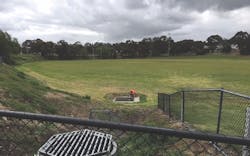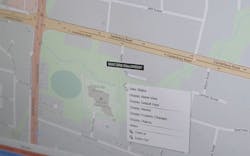About the author:
Jason Leppin is systems engineer at Sage Automation. Leppin can be reached at [email protected].
Water authorities around the world face the same challenge. They must manage hundreds or thousands of underground water assets that are difficult to access and costly to monitor.
Critical above-ground assets such as plants, pump stations, tanks and reservoirs are commonly monitored, but below-ground assets like manholes and pipelines have been literally left in the dark, due to lack of accessibility and technology, as well as costs involved.
The Melbourne Water Challenge
In Melbourne, Australia, Melbourne Water wanted to monitor the manholes and water levels at more than 200 retarding basins throughout greater Melbourne. A retarding basin is an area of land used for storm water to drain into during high-rainfall events.
Monitoring these sites would allow Melbourne Water to better manage storm water flows by receiving live alerts of potential overflows and warning residents of potential flooding events.
Remote monitoring of low-lying sites allows for better storm water management and public warning systems.
The Solution
Sage Automation delivered a low cost, maintainable solution for monitoring 38 of Melbourne Water’s most critical retarding basins. The solution incorporated remote terminal unit (RTU) data loggers, field sensor devices and Sage’s cloud-based SCADA service STRATUS for interim alarming and visualization. Field works were managed by ALS Global and supported by Sage with three key objectives:
1. Wide area monitoring of low-lying sites with no power;
2. Use current IT infrastructure and set up communications; and
3. Reduce capital costs with a speedy roll-out.
Melbourne Water achieved remote monitoring of 70+ below ground and low-lying assets at speed (Objectives 1 and 3). This was achieved with a purpose-built, cloud-based SCADA interface with a similar user experience to the existing system, without the capital infrastructure outlay (Objective 2). Users could securely log in via an internet browser to monitor, respond to alarms and extract data for reporting (Objectives 1 and 2). The hardware and devices selected are energy efficient and have a battery life of up to five years.
In addition, the devices have an IP68 rating, are intrinsically safe for hazardous locations and can be installed anywhere using power type pillars, bollards or dedicated underground pits (Objectives 1 and 3). One of the sites had hardware supplied, configured and installed within 24 hours, illustrating how quickly this cloud-based infrastructure can be used (Objective 3).
There also were environmental and social impacts, as Melbourne Water now can better manage the city’s waterway health and provide better communication to its customers based on the collected data. In addition, historical monitoring data can now be fed into environmental planning and design for future public spaces and water assets. This translates into cost savings for the water authority and better services for the public.
Project Delivery
Sage’s project delivery team worked to achieve the objectives listed above. The first step was to address site requirements. These low-lying sites typically do not have main power, so a battery-operated monitoring system using a sleep-based RTU data logger was required. However, Melbourne Water’s SCADA infrastructure was unable to support the sleep-type devices required.
After a trial and selecting the best RTU data loggers, Sage investigated workaround SCADA solutions, which involved testing a SCADA virtual machine. This testing lead to the ultimate cloud-based SCADA solution.
The SCADA platform and cloud service provider needed to meet all telemetry requirements, plug-in tools and support multiple device types and protocols. As such, Stratus was built with ClearSCADA and Amazon Web Services (AWS). ClearSCADA was chosen for its telemetry features, support for remote device downloads and Sage’s extensive experience with this technology. AWS was chosen for its reliability, elastic computing capacity, comprehensive prebuilt tools, and its physical server located in Australia.
Unfortunately, the current nature of networking solutions with IoT means some control is handed over to the telecommunication providers. Since the solution used a 3G and 4G network and sim-cards, it required a telecommunications company that would make data-plan changes on the fly. Such requirements are borderline impossible with some providers, so Sage built a relationships with a telecommunications company to ensure it could make changes within minutes. Second to this, Sage was able to interface services through the cloud, including building a Sigfox IoT interface and more recently accessing remote data from long-range IoT.
This solution ultimately enabled the utility to achieve wider area monitoring of its assets in record speed and without the capital outlay, thus achieving all project objectives.
Connected Devices & SCADA
The logistics of finding and implementing the solution were complex. The field devices had to be non-powered and non-solar, a problem easily solved by fitting the RTU data logger with an external battery for three to five years of power. The monitoring hardware is battery powered, so it does not draw energy from the grid.
In addition, the solution required secure wireless communications that connected to the water authority’s SCADA system, with additional IT infrastructure being required to allow this. To bridge this gap, Stratus was used as an interim solution. This allowed Melbourne Water to take the time to develop its end solution and install the appropriate
IT infrastructure.
Environmental & Resource Benefits
The first benefit is better waterway management. Melbourne Water now is performing wide-area, low-cost monitoring of previously unmonitored low-lying sites. As such, it can now gain baseline data to feed into its Water Sensitive Urban Design (WSUD) programs. The water authority also is alerted to potential flooding events with real-time alarming, which increases response times and any communication to the public. These capabilities enable Melbourne Water to better manage storm water to reduce waterway pollution, sedimentation and flooding.
Secondly, it had a small environmental footprint. The solution did not require an upfront infrastructure upgrade. This meant less capital expenditure but also less environmental footprint. Cloud computing offers the ability to scale wide-area site monitoring without installing physical data servers or new control systems on site. These servers require continuous temperature control, security and fire backup systems, all of which draw on resources to run. By harnessing a central server shared by thousands of other businesses across the world, Melbourne Water has reduced its environmental footprint.
Third, the RTU data logger hardware is battery powered, so it does not draw energy from the grid, meaning energy costs are reduced. In addition, the devices are designed to go into sleep-mode when not in use, which makes them long lasting (more than five years) and energy efficient.
Lastly, the project has paved the way for other utilities and businesses, thus scaling the environmental benefits. This includes harnessing cloud computing for a smaller infrastructure footprint and applying Stratus to solve other monitoring problems, such as leakage and blockage detections.
Community Benefits
Melbourne Water’s new ability to gather, monitor and analyze site water data at previously unmonitored sites means it can better respond to potential flooding events and communicate these to the public. Amenities such as roads, buildings and nearby homes are more protected as a result of the new capability. Monitoring of water assists enable the water authority to deliver clear communication when it is required. More importantly, historical monitoring data can now be fed into environmental planning and design for future public spaces and water assets. This translates into cost savings to the utility and better services for the public.
The solution is non-invasive and near invisible to the public. Because it is remotely monitored, it reduces the need for site visits, thus there is less site disturbance to the aesthetics, nature and people.
The Outcome
Melbourne Water is monitoring below-ground assets with affordable implementation and maintenance costs. In particular, Melbourne Water is in transition from no monitoring to monitoring of 38 retarding basins; is conducting low cost, wide-area site monitoring for below ground assets; can prevent and react to spilling and flooding events with real-time alarming; and has access to 15,000 data points and three WebEx clients through Stratus.
Continued maintenance of water and wastewater infrastructure, including the reliability of monitoring and control systems, is paramount to addressing the challenges facing the water industry. The 2018 Australian Industry Standards Water Industry Key Findings Paper states that delivering a stable and reliable water supply into the future will require new technologies and systems that are capable of monitoring water resources in real-time. IoT and the increasing prevalence of internet connected-devices in our world are central to this new capability.
Editor's Note: SAGE Automation is a certified member of the Control System Integrators Association (CSIA). Visit the company profile here, https://bit.ly/2r9h6TI.




